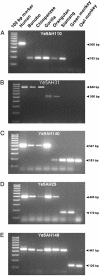Alu elements and hominid phylogenetics
- PMID: 14561894
- PMCID: PMC240696
- DOI: 10.1073/pnas.2133766100
Alu elements and hominid phylogenetics
Abstract
Alu elements have inserted in primate genomes throughout the evolution of the order. One particular Alu lineage (Ye) began amplifying relatively early in hominid evolution and continued propagating at a low level as many of its members are found in a variety of hominid genomes. This study represents the first conclusive application of short interspersed elements, which are considered nearly homoplasy-free, to elucidate the phylogeny of hominids. Phylogenetic analysis of Alu Ye5 elements and elements from several other subfamilies reveals high levels of support for monophyly of Hominidae, tribe Hominini and subtribe Hominina. Here we present the strongest evidence reported to date for a sister relationship between humans and chimpanzees while clearly distinguishing the chimpanzee and human lineages.
Figures




References
Publication types
MeSH terms
Substances
Associated data
- Actions
- Actions
- Actions
- Actions
- Actions
- Actions
- Actions
- Actions
- Actions
- Actions
- Actions
- Actions
- Actions
- Actions
- Actions
- Actions
- Actions
- Actions
- Actions
- Actions
- Actions
- Actions
- Actions
- Actions
- Actions
- Actions
Grants and funding
LinkOut - more resources
Full Text Sources
Research Materials

